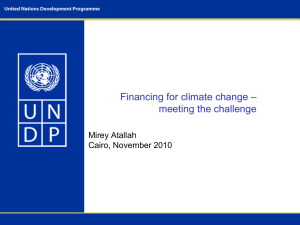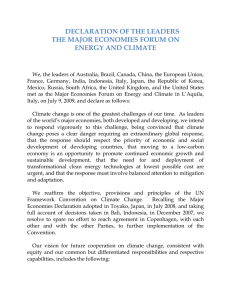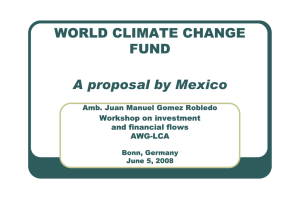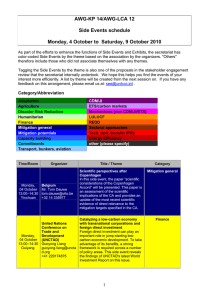Presentation by Mr. Tariq Banuri, Senior Fellow and Director, Future Sustainability Programme, Stockholm Environment Institute
advertisement
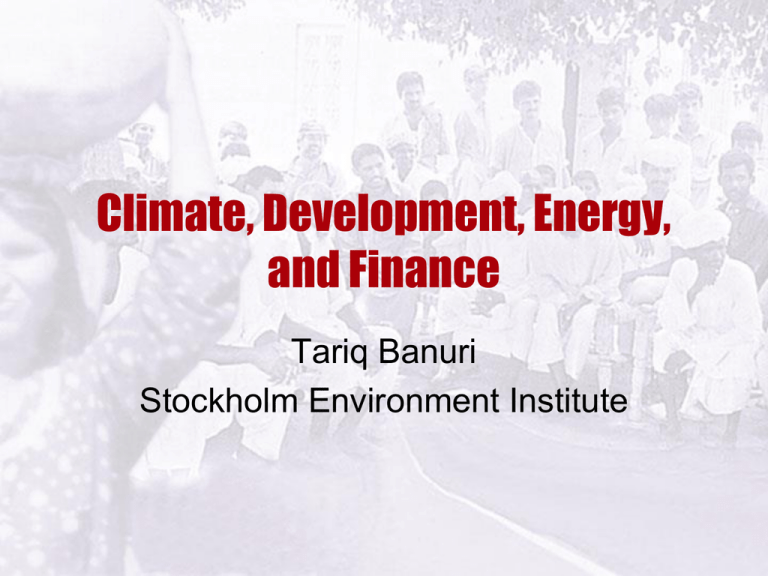
Climate, Development, Energy, and Finance Tariq Banuri Stockholm Environment Institute Alternative Approaches • The Climate Community: Aim for a comprehensive solution – Start with emission goals and work backwards • Development: Protect development momentum – Start with development goals, and identify options, both domestic and international • Finance: Start with available financing – Alternative instruments: CDM (scale, structure), Carbon Tax, Clean energy financing – Start with available financing and work forwards • Is there a fourth possibility? The Climate Community Emission Trajectories for 450 ppm 80% global reductions by 2050 What’s left for the South? 90% by 2050 in the North What kind of climate regime can make this possible? An Alternative Conception Implications • Targets are essential for both North and South • Economic instruments will work only if targets are realistic • Conceptions are often developmentblind and financing-blind The Development Community Source: UN/DESA, WESS 2006 Emissions and Income Carbon Emissions/Capita (tons) 14.00 Qatar 12.00 10.00 United Arab Emirates 8.00 Luxembourg Bahrain 6.00 Singapore United States Australia 4.00 Norway Canada Saudi Arabia Czech Republic Japan 2.00 Switzerland Hong Kong, China 0.00 0 5,000 10,000 15,000 20,000 GDP/Capita (PPP$) Source: World Bank (1998); Marland, et al. (1998). 25,000 30,000 35,000 The Five Development Crises 1. Traditional development and MDGs – Solution: conventional financial flows 2. The impact of climate change – Solution: Financial and support for adaptation 3. Impact of OECD climate policies (e.g., carbon tax) – Solution: Policy coherence in North 4. Impact of own climate policies (especially energy) – Solution: New and additional resources for mitigation and adaptation 5. The growth conundrum: Has the age of growth come to an end? Energy is a Basic Human Need • Main difference between rich and poor countries • Strongly correlated with HD indicators • Developing countries must expand electricity and transport infrastructure three to four times just to reach basic needs goals • Expansion is constrained not by demand (efficiency, population) but by supply (investment capacity). • Over 75% emissions from the energy sector • Projected developing country energy growth (3 to 5%) means more emissions despite rising energy efficiency. Developing Country Energy Deficit Energy Consumption per capita 2000 2005 2030 OECD ~5.1 ~5.6 ~6.9 EIT ~1.0 ~1.1 ~1.8 Developing Countries ~3.6 4.7 ~9 World ~9.7 11.4 17.7 The Development Finance Community Policy Instruments • The Carbon Market and CDM – However, there are implicit assumptions: pilot scale will give rise to cost reduction and voluntary action – Can it respond to conceptions of climate and development communities, e.g., through larger commitments by Annex I? • Carbon Tax – However, impact through energy prices on developing countries – Dual pricing and institutions Scenarios: Path Dependency of Crises • The post-Manhattan: Dedicated and timely global public investment in mitigation as well as building capacity for adaptation. Worst outcomes are avoided. By the time the issue begins to bite, costs come down for both north and south. Financing remains an issue, but not the dominant one • The post-Titanic: Mitigation delayed, impacts begin to emerge. Major climate impacts on North lead to anxiety, and public pressure for action on climate. High support for mitigation, but this leads to slowdown of OECD growth rate, and weakening of public support for adaptation funding or development aid • The post-Tsunami: North is relatively unaffected. Climate impacts in South lead to strong charitable contributions for rehabilitation and compensation. An Integrated Perspective The Case for CDGs • From action to finance, and action to policy • Build a global consensus on goals • Integrate climate and development – Enhance coordination between different actors – Enable more effective monitoring the relation between challenge and response – Give clear signals to private sector UN’s Role in MDGs • Convening power to build consensus on the goals, i.e., Millennium Declaration. • Translate the visionary agenda into practical goals and indicators of progress • Mobilize expertise to design an action program to achieve the goals • Continue to monitor goals Illustrative CDGs 1. Ensure equitable access to Modern Energy Services while reducing greenhouse gas emissions 2. Shift to sustainable, efficient, and equitably distributed Transport services 3. Ensure Food security through sustainable land use management, and sustainable water use 4. Ensure adequate and well targeted financing 5. Support technology development and cooperation 6. Ensure sustained improvements in human health 7. Enable critical ecosystems to adapt naturally 8. Ensure effective disaster management CDG1: Energy • Coverage: Universal coverage by 2030, or convergence in per capita availability between North and South • Access and equity: stable pricing fixed in relation to per capita income • Portfolio: Fix share of renewables • Efficiency: National targets CDG4: Finance • Win-win options: Reserved for domestic financing • International targets based on income, capacity, and responsibility • Separate targets on conventional ODA (plus MDGs), mitigation, and adaptation • Planning and Policy Making: Support for plan development


